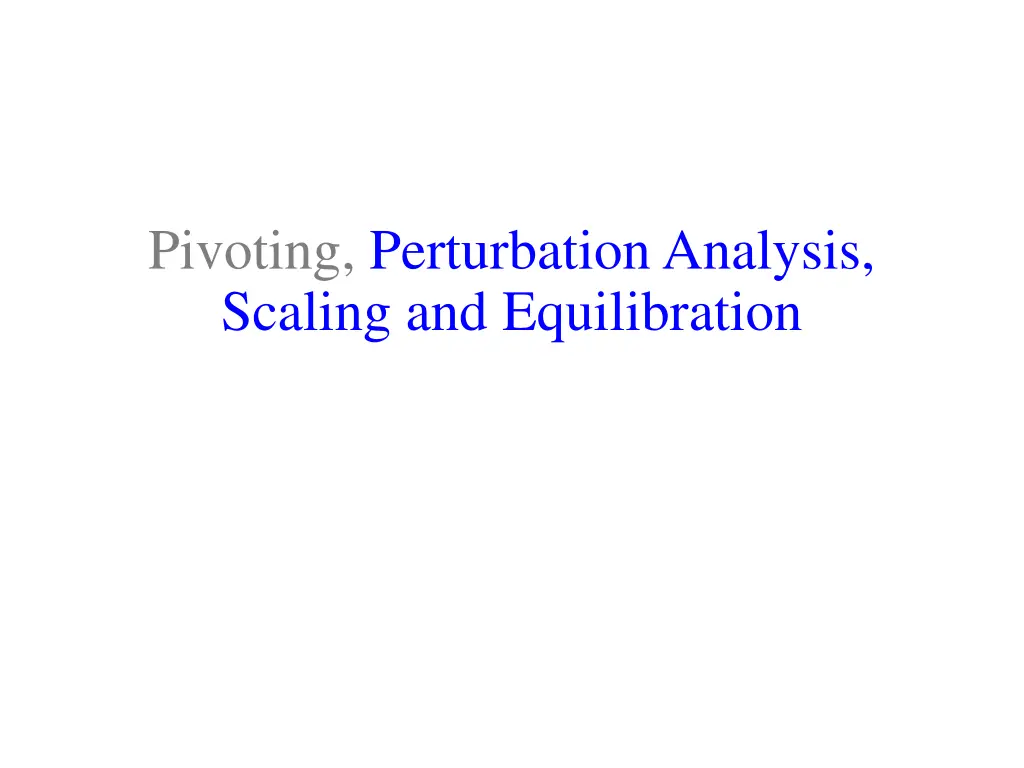
Matrix Conditioning and Perturbation Analysis Techniques
Dive into the world of matrix conditioning, perturbation analysis, and scaling techniques to understand how small changes in matrices and vectors can impact solution accuracy. Learn about condition numbers, sensitivity to perturbations, and the importance of scaling for better computational accuracy in solving equations.
Download Presentation

Please find below an Image/Link to download the presentation.
The content on the website is provided AS IS for your information and personal use only. It may not be sold, licensed, or shared on other websites without obtaining consent from the author. If you encounter any issues during the download, it is possible that the publisher has removed the file from their server.
You are allowed to download the files provided on this website for personal or commercial use, subject to the condition that they are used lawfully. All files are the property of their respective owners.
The content on the website is provided AS IS for your information and personal use only. It may not be sold, licensed, or shared on other websites without obtaining consent from the author.
E N D
Presentation Transcript
Pivoting, Perturbation Analysis, Scaling and Equilibration
Perturbation Analysis Consider the system of equation Ax = b Question: If small perturbation, ??, is given in the matrix A and/or ?? in the vector b, what is the effect ?? on the solution vector x ? Alternatively: how sensitive is the solution x to small perturbations in the coefficient matrix, ??, and the forcing function, ?? ?
Perturbation in forcing vector b: System of equation: A(x + x)=(b + b) A x = b since, Ax = b x =- A-1 b Take the norms of vectors and matrices: ?? = ? ??? ? ? ?? ?? ? = ? ? ? ?? ? = ? ? ?? ?? ? ? ? ? ? ?? ? ?? ? ? ? ?
Perturbation in matrix A: System of equation: (A + A)(x + x)= b A x + A(x + x)=0 since, Ax = b x =- A-1 A(x + x) Take the norms of vectors and matrices: ?? = ? ??? ? + ?? ? ? ? ? ?? ?? ? + ?? ?? ? + ? ? ?? Product of perturbation quantities (negligible) ?? ? ?? ? ? ? ?
Condition Number: Condition number of a matrix A is defined as: ? ? = ? ? ? ? ?is the proportionality constant relating relative error or perturbation in A and b with the relative error or perturbation in x Value of ? ? depends on the norm used for calculation. Use the same norm for both A and A-1. If ? ? 1 or of the order of 1, the matrix is well- conditioned. If ? ? 1, the matrix is ill-conditioned.
Since ? ? 1, the matrix is ill-conditioned. 6
Is determinant a good measure of matrix conditioning? 8
Scaling and Equilibration: It helps to reduce the truncation errors during computation. Helps to obtain a more accurate solution for moderately ill- conditioned matrix. Example: Consider the following set of equations Scale variable x1 = 103 x1 and multiply the second equation by 100. Resulting equation is:
Scaling Vector x is replaced by x such that, x = Sx . S is a diagonal matrix containing the scale factors! For the example problem: Ax = b becomes: Ax = ASx = A x = b where, A = AS For the example problem: Scaling operation is equivalent to post-multiplication of the matrix A by a diagonal matrix S containing the scale factors on the diagonal
Equilibration Equilibration is multiplication of one equation by a constant such that the values of the coefficients become of the same order of magnitude as the coefficients of other equations. The operation is equivalent to pre-multiplication by a diagonal matrix E on both sides of the equation. Ax = b becomes: EAx = Eb For the example problem: 1 0 0 0 102 0 0 0 1 0.0015 0.966 0.003 1.45 0.002 0.96 0.0015 0.966 Equilibration operation is equivalent to pre-multiplication of the matrix A and vector b by a diagonal matrix E containing the equilibration factors on the diagonal ?1 ?2 ?3 ?1 ?2 ?3 1 0 0 0 0 0 1 11 0.12 19 0.003 0.00002 1.45 0.0096 0.3 102 0 = 0.0021 0.201 0.3 0.21 0.201 11 12 19 =
Example Problem Does the solution exist for complete pivoting? ?1 ?2 ?3 10 5 10 5 1 10 5 10 5 1 2 10 5 2 10 5 1 1 1 2 = a) Perform complete pivoting and carry out Gaussian elimination steps using 3-digit floating-point arithmetic with round-off. Explain the results. b) Rewrite the set of equations after scaling according to x 3 = 105 x3 and equilibration on the resulting equations 1 and 2. Solve the system with the same precision for floating point operations.
Pivoting, Scaling and Equilibration (Recap) Before starting the solution algorithm, take a look at the entries in A and decide on the scaling and equilibration factors. Construct matrices E and S. Transform the set of equation Ax = b to EASx = Eb Solve the system of equation A x = b for x , where A = EAS and b = Eb Compute: x = Sx Gauss Elimination: perform partial pivoting at each step k For all other methods: perform full pivoting before the start of the algorithm to make the matrix diagonally dominant, as far as practicable! These steps will guarantee the best possible solution for all well- conditioned and mildly ill-conditioned matrices! However, none of these steps can transform an ill-conditioned matrix to a well-conditioned one.
Iterative Improvement by Direct Methods For moderately ill-conditioned matrices an approximate solution x to the set of equations Ax = b can be improved through iterations using direct methods. Compute: r = b - Ax Recognize: r = b - Ax + Ax - b Therefore: A(x - x ) = A x = r Compute: x = x + x The iteration sequence can be repeated until x
Solution of System of Nonlinear Equations
System of Non-Linear Equations f(x) = 0 f is now a vector of functions: f = {f1, f2, fn}T x is a vector of independent variables: x = {x1, x2, xn}T Open methods: Fixed point, Newton-Raphson, Secant
Open Methods: Fixed Point Rewrite the system as follows: f(x) = 0 is rewritten as x = (x) Initialize: assume x (0) Iteration Step k: x(k+1) = (x (k)), initialize x (0) ??+1 ?? ??+1 Stopping Criteria: ?
Open Methods: Fixed Point Condition for convergence: For single variable: g ( ) < 1 For multiple variable, the derivative becomes the Jacobian matrix ? whose elements are ???=??? ???. ??1 ??1 ??2 ??1 ??1 ??2 ??2 ??2 Example 2-variables: ? = Sufficient Condition: ? < 1 Necessary Condition: Spectral Radius, ? ? < 1
Open Methods: Newton-Raphson Example 2-variable:f1(x, y) = 0 and f2(x, y) = 0 2-d Taylor s series: ??1 ?? 0 = ?1??+1,??+1=?1??,?? + ??+1 ?? + ??,?? ??1 ?? ??+1 ?? + ??? ??,?? ??2 ?? 0 = ?2??+1,??+1=?2??,?? + ??+1 ?? + ??,?? ??2 ?? ??+1 ?? + ??? ??,?? ??1 ?? ??2 ?? ??1 ?? ??2 ?? ??+1 ?? ??+1 ?? ?1??,?? ?2??,?? = ??,??
Open Methods: Newton-Raphson Initialize: assume x (0) Recall single variable: 0 = ? ??+1 = ? ?? + ??+1 ??? ?? + ??? Multiple Variables: 0 = ? ?(?+1)= ? ?(?)+ ? ?(?) ?(?+1) ?(?)+ ??? Iteration Step k: ? ?? ? = ? ??; ??+1= ??+ ? ??+1 ?? ??+1 Stopping Criteria: ?
Open Methods: Newton-Raphson Example 2-variable: ??1 ??1 ??2 ??1 ??1 ??2 ??2 ??2 ?,?2 ? ?1 ?1 ?1 ?2 = ?,?2 ? ?2 ?1 ?,?2 ? ?1 ?+1 ?1 ? ?+1 ? ?1 ?1 ?2 ?1 ?2 ?1 ?2 = = ?+1 ? ?+1 ?2 ? ?2 ?+1 ? ?1 ?2 ?1 ?2 + ?1 ?2 = ?+1 ?
Example Problem: Tutorial 3 Q2 Solve the following system of equations ( ) , ( , ) 5 v x y x xy = = + = 2 0.75 0 u x y x x y f(x) = 0 = 2 0 y using: (a) Fixed-point iteration (b) Newton-Raphson method starting with an initial guess of x = 1.2 and y = 1.2. Solution: Iteration Step k: ? ?? ? = ? ??; ??+1= ??+ ? ??+1 ?? ??+1 Stopping Criteria: ?
Open Methods: Newton-Raphson Example 2-variable: ?? ??1 ?? ??1 ?? ??2 ?? ??2 ?,?2 ? ? ?1 ?1 ?2 = ?,?2 ? ? ?1 ?,?2 ? ?1 ?+1 ?1 ? ?+1 ? ?1 ?1 ?2 ?1 ?2 ?1 ?2 = = ?+1 ? ?+1 ?2 ? ?2 ?+1 ? ?1 ?2 ?1 ?2 + ?1 ?2 = ?+1 ?
Open Methods: Secant Jacobian of the Newton-Raphson method is evaluated numerically using difference approximation. Numerical methods for estimation of derivative of a function will be covered in detail later. Rest of the method is same.






















